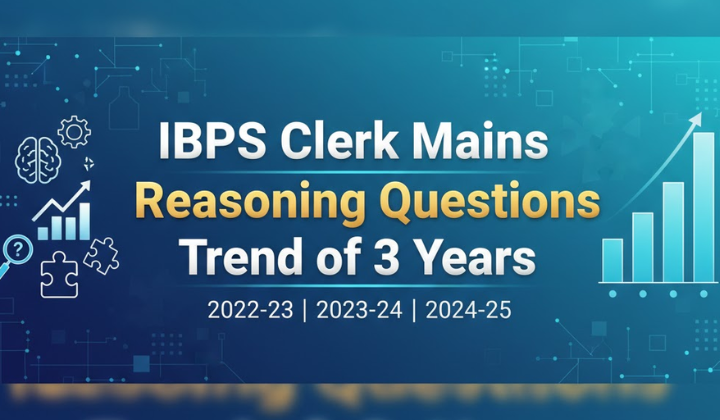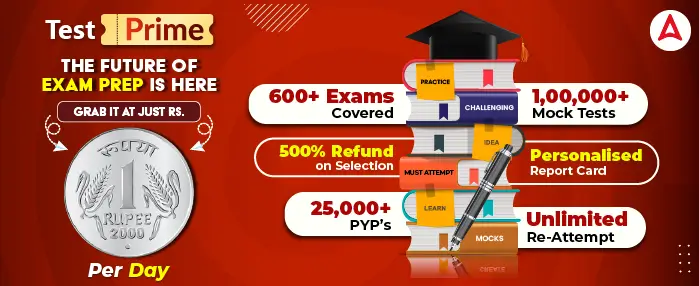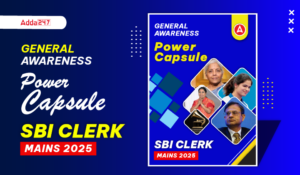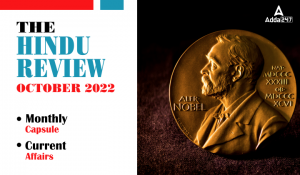The IBPS Clerk Mains Exam is approaching, and candidates must shift their focus toward strategic preparation rather than relying solely on hard work. In the final days, it becomes crucial to revise important topics, practice high-level questions, and analyze weak areas with precision. Smart preparation such as timed quizzes, concept-wise revision, and regular mock test analysis helps boost accuracy and confidence.
IBPS Clerk Mains Reasoning Questions Trend of 3 Years
To support candidates in understanding the exam pattern better, we have shared the IBPS Clerk Mains Reasoning Question Trends of the Last 3 Years. This trend analysis highlights recurring topics, shifting difficulty levels, and the types of puzzles or logical reasoning sets that frequently appear. By studying these trends, candidates can prioritize high-weightage areas, predict possible question patterns, and optimize their revision strategy.
IBPS Clerk Mains Reasoning Questions Weightage & Trend
IBPS Clerk Mains Reasoning section has remained puzzle-dominated over the last 3 years, with consistent weightage to logical reasoning, machine input–output, and data sufficiency, while introducing small pattern shifts each year. Overall difficulty has stayed at moderate to moderate‑high, mainly due to lengthy puzzles and new pattern variants rather than brand‑new topics.
| Topic | 2024 Questions | 2023 Questions | 2022 Questions |
| Logical Reasoning | 10 | 10 | 10 |
| Machine Input Output | 5 | 5 | 5 |
| Data Sufficiency | 4 | 4 | 3 |
| Resultant Based | 4 | 4 | 0 |
| Box Based Puzzle | 1 | 5 | 0 |
| Blood Relation Based | 5 | 0 | 0 |
| Square Based + Circle Inside | 5 | 0 | 0 |
| Post Based + Variable | 5 | 5 | 0 |
| Miscellaneous | 3 | 3 | 0 |
| Multiple Series With Condition | 2 | 0 | 0 |
| Word Based | 1 | 0 | 0 |
| Day Based Puzzle | 1 | 0 | 0 |
| Syllogism | 0 | 3 | 3 |
| Coded Inequality | 0 | 3 | 3 |
| Circular/Seating Arrangement | 0 | 5 | 5 |
| Direction & Distance | 3 | 2 | 3 |
| Floor/Flat Based Puzzle | 0 | 0 | 3 |
| Scheduling Puzzle | 0 | 0 | 3 |
| Age Based Puzzle | 0 | 0 | 5 |
| Matrix Based Puzzle | 0 | 0 | 5 |
| Hexagonal Seating | 0 | 0 | 5 |
Puzzle & Seating Arrangement
From 2022 to 2024, puzzles and seating arrangements like square/circle/linear/floor/flat/hexagonal, box, age, scheduling, matrix, and post/variable-based puzzles make up about 15–25 questions in each paper. This makes them the largest and most time-consuming part of the Reasoning section.
The types of puzzles keep changing (for example, square + circle inside in 2024, or hexagonal/floor/flat/matrix, and year/age/post/scheduling sets), but puzzles consistently remain the core and most important part of the section.
Logic & Critical Reasoning
Logical reasoning including course of action, assumption, conclusion, inference, argument, and paragraph-based questions usually has 6–10 questions each year. In 2023 and 2024, it accounted for 10 marks in the exam. This section is now a stable, high-scoring part of Reasoning. It tests reading and judgment more than calculations or arrangements, so candidates should treat it as a separate sub-topic while preparing.
Machine Input Output & Series/Coding
Machine Input–Output shows up every year, usually with 3–5 questions. Recently, the sets mix number-based and word+number patterns and often test step-by-step logic rather than simple shifts. Step-based alphanumeric series, multiple series with conditions, and resultant/coding-based sets are now more common than basic series or simple coding-decoding. These “processed” series questions require careful logical steps to solve.
Syllogism, Inequality, Direction & Blood Relation
Syllogism and coded inequality usually make up around 5–6 questions together. For example, in 2023 both topics appeared (3 + 3), but in 2024 some shifts had no syllogism at all, showing that IBPS can skip traditional topics occasionally. Direction–distance and blood relation continue to appear every year. They show up as 2–3 direct questions and also get included inside puzzles or data-sufficiency sets.
Data sufficiency & Miscellaneous
Data Sufficiency has become a fixed part of the exam, with 3–4 questions asked every year. These usually come in a two-statement or three-statement format and are based on topics like box puzzles, blood relations, seating arrangements, and year/day-based setups.
Each year also includes a small set of 3–4 miscellaneous questions. These are usually word-based, meaningful word formation, odd one out, or basic logical checks. They are quicker to solve and offer easy scoring opportunities compared to the lengthy puzzle sets.




 GA Capsule for SBI Clerk Mains 2025, Dow...
GA Capsule for SBI Clerk Mains 2025, Dow...
 The Hindu Review October 2022: Download ...
The Hindu Review October 2022: Download ...
 The Hindu Review October 2025, Download ...
The Hindu Review October 2025, Download ...








